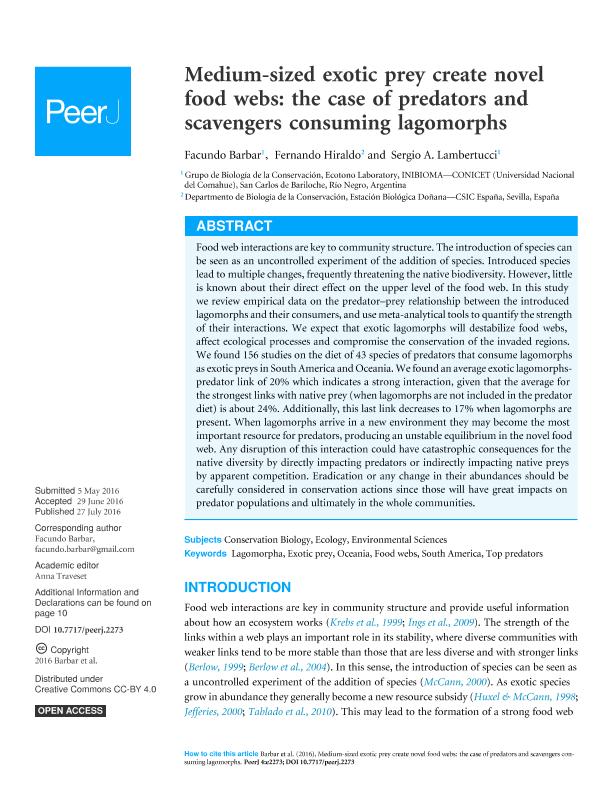Mostrar el registro sencillo del ítem
dc.contributor.author
Barbar, Facundo

dc.contributor.author
Hiraldo, Fernando

dc.contributor.author
Lambertucci, Sergio Agustin

dc.date.available
2021-02-19T14:21:57Z
dc.date.issued
2016-07
dc.identifier.citation
Barbar, Facundo; Hiraldo, Fernando; Lambertucci, Sergio Agustin; Medium-sized exotic prey create novel food webs: The case of predators and scavengers consuming lagomorphs; PeerJ Inc.; PeerJ; 2016; 7; 7-2016; 1-15
dc.identifier.issn
2167-8359
dc.identifier.uri
http://hdl.handle.net/11336/126081
dc.description.abstract
Food web interactions are key to community structure. The introduction of species can be seen as an uncontrolled experiment of the addition of species. Introduced species lead to multiple changes, frequently threatening the native biodiversity. However, little is known about their direct effect on the upper level of the food web. In this study we review empirical data on the predator-prey relationship between the introduced lagomorphs and their consumers, and use meta-analytical tools to quantify the strength of their interactions. We expect that exotic lagomorphs will destabilize food webs, affect ecological processes and compromise the conservation of the invaded regions. We found 156 studies on the diet of 43 species of predators that consume lagomorphs as exotic preys in South America and Oceania. We found an average exotic lagomorphspredator link of 20% which indicates a strong interaction, given that the average for the strongest links with native prey (when lagomorphs are not included in the predator diet) is about 24%. Additionally, this last link decreases to 17% when lagomorphs are present. When lagomorphs arrive in a new environment they may become the most important resource for predators, producing an unstable equilibrium in the novel food web. Any disruption of this interaction could have catastrophic consequences for the native diversity by directly impacting predators or indirectly impacting native preys by apparent competition. Eradication or any change in their abundances should be carefully considered in conservation actions since those will have great impacts on predator populations and ultimately in the whole communities.
dc.format
application/pdf
dc.language.iso
eng
dc.publisher
PeerJ Inc.
dc.rights
info:eu-repo/semantics/openAccess
dc.rights.uri
https://creativecommons.org/licenses/by/2.5/ar/
dc.subject
EXOTIC PREY
dc.subject
FOOD WEBS
dc.subject
LAGOMORPHA
dc.subject
OCEANIA
dc.subject
SOUTH AMERICA
dc.subject
TOP PREDATORS
dc.subject.classification
Conservación de la Biodiversidad

dc.subject.classification
Ciencias Biológicas

dc.subject.classification
CIENCIAS NATURALES Y EXACTAS

dc.title
Medium-sized exotic prey create novel food webs: The case of predators and scavengers consuming lagomorphs
dc.type
info:eu-repo/semantics/article
dc.type
info:ar-repo/semantics/artículo
dc.type
info:eu-repo/semantics/publishedVersion
dc.date.updated
2021-02-09T18:51:56Z
dc.journal.volume
2016
dc.journal.number
7
dc.journal.pagination
1-15
dc.journal.pais
Estados Unidos

dc.description.fil
Fil: Barbar, Facundo. Consejo Nacional de Investigaciones Científicas y Técnicas. Centro Científico Tecnológico Conicet - Patagonia Norte. Instituto de Investigaciones en Biodiversidad y Medioambiente. Universidad Nacional del Comahue. Centro Regional Universidad Bariloche. Instituto de Investigaciones en Biodiversidad y Medioambiente; Argentina
dc.description.fil
Fil: Hiraldo, Fernando. Consejo Superior de Investigaciones Científicas. Estación Biológica de Doñana; España
dc.description.fil
Fil: Lambertucci, Sergio Agustin. Consejo Nacional de Investigaciones Científicas y Técnicas. Centro Científico Tecnológico Conicet - Patagonia Norte. Instituto de Investigaciones en Biodiversidad y Medioambiente. Universidad Nacional del Comahue. Centro Regional Universidad Bariloche. Instituto de Investigaciones en Biodiversidad y Medioambiente; Argentina
dc.journal.title
PeerJ
dc.relation.alternativeid
info:eu-repo/semantics/altIdentifier/url/https://peerj.com/articles/2273/
dc.relation.alternativeid
info:eu-repo/semantics/altIdentifier/doi/http://dx.doi.org/10.7717/peerj.2273
Archivos asociados
